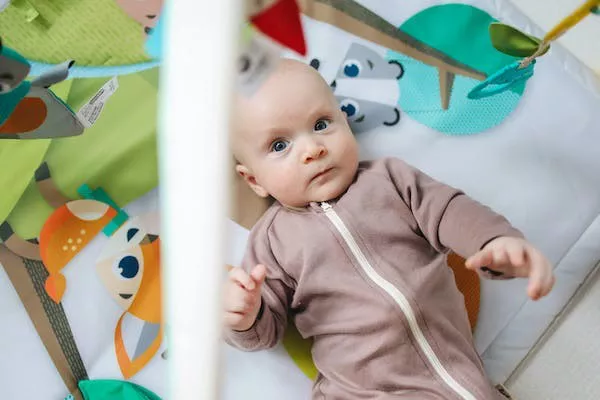In the early stages of life, the visual perception of infants is a fascinating subject of study. As new parents or caregivers, understanding what infants see and how their vision develops is crucial to supporting their growth and creating a conducive environment. In this article, we will delve into five aspects of infant vision, exploring the milestones and progressions they go through in their visual journey.
Visual Acuity:
Visual acuity refers to the sharpness of an individual’s vision. In the first few months of life, infants’ visual acuity is relatively poor, but it improves gradually. Newborns can only perceive objects within close proximity, typically within 8 to 12 inches from their face. As their eyes and brain develop, they become more adept at focusing on distant objects and fine details. By the age of one, most infants reach 20/20 vision, similar to adults, allowing them to discern objects from afar.
Color Perception:
The ability to perceive colors is an intriguing aspect of infant vision. At birth, infants have limited color vision and are believed to see the world in shades of gray and high contrast. As they age, particularly around 2 to 3 months, their color vision begins to develop, and they can distinguish between different hues. Research suggests that babies might be more sensitive to certain colors, such as red and yellow, during their early months.
Depth Perception:
Depth perception is the ability to perceive the three-dimensional nature of the world and judge distances accurately. Infants are not born with fully developed depth perception. Around 4 to 6 months, they start to gain the ability to perceive depth cues, such as binocular disparity and motion parallax. These cues allow them to gauge the relative distances of objects and enhance their spatial awareness.
Visual Tracking:
Visual tracking is the ability to follow moving objects with the eyes. During the first weeks of life, infants’ eye movements might seem erratic and uncoordinated. However, as they mature, usually around 2 to 3 months, their visual tracking improves significantly. This skill is essential for their cognitive and motor development, as it helps them explore their surroundings and interact with the environment.
Object Recognition:
Infants’ ability to recognize and differentiate objects is an essential aspect of their visual development. Early on, they are drawn to high contrast patterns and simple shapes. As their visual system matures, typically around 4 to 6 months, they become more proficient at recognizing familiar faces and objects. This recognition plays a vital role in forming attachments and understanding their surroundings.
Conclusion:
Understanding what infants can see and how their vision develops is a key aspect of early childcare and parenting. As infants progress through various developmental stages, their visual abilities undergo significant changes. From blurry vision to sharp focus, and from limited color perception to a vibrant world of colors, each milestone brings them closer to a complete visual experience. By providing a nurturing and stimulating environment, caregivers can support and enhance infants’ visual development, paving the way for their overall growth and well-being.
FAQs About Infants’ Visual Acuity
1. How is visual acuity measured in infants?
Measuring visual acuity in infants is different from the standard eye chart used for adults. Since infants cannot communicate or read letters, specialized techniques are employed. One common method is the preferential looking test, where infants are presented with two patterns or images—one simple and the other with finer details. By observing which image the infant looks at more frequently, eye care professionals can gauge their visual acuity.
2. When do infants reach 20/20 vision?
At birth, infants’ vision is significantly less sharp than that of adults. It takes time for their visual system to mature and attain 20/20 vision, which is considered the standard for normal adult vision. Most infants reach this level of visual acuity by the age of one year, although there may be individual variations. It is essential to remember that achieving 20/20 vision is part of a natural developmental process.
3. Can infants see colors?
Yes, but initially, their color vision is limited. At birth, infants’ color perception is believed to be somewhat restricted, and they may see the world in shades of gray and high contrast. However, as they grow and their visual system develops, they become more capable of perceiving colors. Around 2 to 3 months, they begin to distinguish between different hues, and their color vision continues to improve with time.
4. Can visual tracking be a cause for concern in infants?
During the first few weeks of life, infants’ eye movements may appear erratic and uncoordinated. This is a normal part of their visual development, and visual tracking typically improves with time. Around 2 to 3 months, infants become more proficient at following moving objects with their eyes. However, if you notice any significant issues with visual tracking or suspect problems with your infant’s eyes, it is essential to consult a pediatric eye care professional for a thorough examination.
5. How does object recognition develop in infants?
Object recognition is crucial for infants’ understanding of their surroundings and forming attachments to caregivers. In the early stages, infants are attracted to high contrast patterns and simple shapes. As they progress, typically around 4 to 6 months, they become more adept at recognizing familiar faces and objects. This developmental milestone is essential for their cognitive and emotional growth.
6. What can parents do to support their infant’s visual development?
Providing a nurturing and stimulating environment can significantly support an infant’s visual development. Placing objects with varying colors and patterns in their vicinity can encourage visual exploration. Engaging in face-to-face interactions and using eye contact promotes bonding and helps develop social and visual skills. Regular check-ups with a pediatric eye care professional are also crucial to ensure any potential vision issues are addressed promptly.


